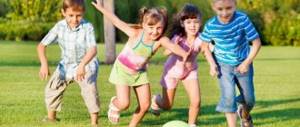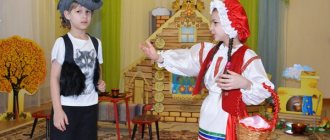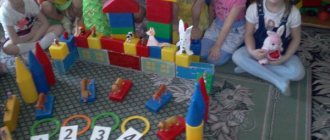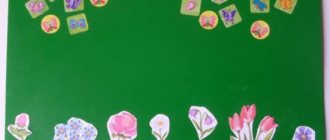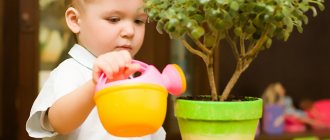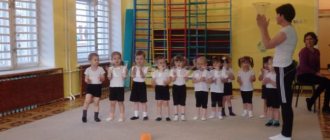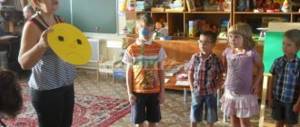To develop an interest in artistic expression and music.
Developmental tasks. Activate children's vocabulary on the topics “Spring”, “Insects”. Stimulate the thinking and speech activity of children. Develop children's communication abilities in communicating with the teacher and each other.
Educational tasks. Cultivate a caring attitude towards all living things. Foster friendly relationships between children.
Equipment. Pictures "Seasons". Insect dummies, Drawn: green leaf, fungus, multi-colored flowers, “Magic wand”, tape recorder. Preliminary work. Examination of illustrations about insects, conversations with children about the signs of the seasons, examination of illustrations “Seasons”, observations during walks. Learning poems about insects. Educational areas. Cognition, communication, music, artistic creativity. Progress of the lesson. Children stand around the teacher, a melody with the sounds of spring sounds. Vocal: Guys, listen to some music. What did you hear? Children's answers. Vosp: What time of year do you think we can hear these sounds? Children's answers. Vosp: That's right, we can hear all these sounds in the spring. Vosp: Guys, tell me what you know about spring, for this we will play with you. The game is called "Show and Tell." Before you are many different pictures about the seasons, you must choose only those pictures that depict the signs of spring and talk about them. Vosp: You are great. And now I propose to go on a short trip to the forest, we can see a lot of interesting things there. And we will take a magic wand with us on our trip, it will help. Vosp: But before we set off, let’s repeat how to behave in the forest. Children's answers. Play with children: Hello, forest, (spread your arms wide to the sides) Beautiful forest, Full of fairy tales and miracles! What are you making noise about in the leaves on a dark, stormy night? Who is hiding in your wilderness? What kind of animal? What bird? Open everything, don’t hide it. . You see we are ours. Vosp: Here we are. Vosp: Guys, look, what is this lying on the path (leaf) Children’s answers. Vosk - l: What color is this leaf? (green) And you know, someone is hiding under the leaf, if you and I solve the riddle, we will find out who was hiding there. From branch to path, from blade of grass to blade of grass. A spring is jumping - Green back (Grasshopper) Children's answers. Vosk: What color is it? What can a grasshopper do? Children's answers. Vosp: And now, with the help of our magic wand, I will turn Dima into a little grasshopper. (we put on a grasshopper cap or mask for the child) Child: In the morning, the grasshopper jumps on the blades of grass, jumps on the leaves, as if he wants to jump around the whole huge world. At noon he gets a good night's sleep, crawling into the cool shade, and he can't sleep all night. - It chirps until the morning. Vosp: Okay, you’re great. Let's continue our journey. Vocal: Listen, how quiet it is in the forest, probably all the forest inhabitants hid from us. If you and I look carefully, we will be able to see them. (There is a mushroom on the way) Vosk: Look how big the mushroom is. Vosp - l: Someone may also be hiding under this mushroom, let us solve another riddle and find out who is hiding under the mushroom. Song: Black, but not a raven, Horned, but not a bull, Six legs, but all without hooves. (Beetle) Children's answers. Vosk - l: I want to look at the beetle with you. What colour is he? What can he do? (children's answers) Vosk: And now, with the help of a magic wand, we will turn into funny beetles for a minute and play the game “Funny Beetle.” The children stand in a circle. In chorus: I am a cheerful cockchafer (children clap their hands) I know all the gardens around. (They spread their arms to the sides) I circle over the lawns (they circle) And my name is Zhuzhu. (Each one points to himself) Don’t bite, you evil mosquito (they shake their finger) I’m already flying home. (Running in circles, waving your arms) Play: Look, guys, how many beautiful flowers there are. (Flower meadow) Vosk: Guys, by solving more riddles, we will be able to recognize the inhabitants of this flower meadow. Flashback: All four petals of a flower are moving, I wanted to pick it, It fluttered up and flew away. (Butterfly) Voss: Tell me, what kind of butterfly? (beautiful, bright, light, colorful) What can a butterfly do? Children's answers. Vosk - l: And now the magic wand will turn Masha into a butterfly. Gelya: He lives, decorating the Earth with himself, fluttering from petal to petal! At the same time, without breaking the silence, She herself is a flying flower! Vocal: Okay. Well done Masha Vosp: And now the next riddle for you guys. This little one is wearing a red polka dot dress. And he can fly deftly. This is (ladybug) Vosk: That's right, of course, this is a ladybug. Play: Look guys, it’s very bright. Let us tell you about the ladybug. What color is it? What can a ladybug do? Children's answers. Vosp: And now the magic wand will help Zoe turn into a ladybug. Zoya: The ladybug has thin wings, red with black specks. She crawls onto the tip of a blade of grass, raises her wings and takes off like a helicopter. Voss: Guys, do you hear this sound? Does it look like someone is crying? Let's see who it is? Children's answers. Vosp: Don’t you know why they cry? Children's answers. Vosp: They lost their black peas, asks us to help them. Vosp: Guys, can we help them? Children's answers. Vosk - l: Let us sit down at the tables and glue black peas to the backs of our ladybugs. Vosk - l: Our ladybugs cheered up and they really liked their black peas. Vosp: We will release them in the clearing. Vosp: And now it’s time for us to return home. Invite children to sit on chairs in front of the magnetic board. Pictures of a beetle, a grasshopper, a ladybug and a butterfly are pasted on a magnetic board. Vosp: Guys, tell me who we met in the forest clearing. Children's answers. And what can we call them all together: beetle, butterfly, grasshopper and ladybug. Children's answers. That's right - these are all insects. What other insects do you know? Children's answers. What color were the grasshopper, butterfly, beetle and ladybug? what body parts do these insects have? Children's answers. Guys, tell me how we should treat insects, animals, birds, plants? Children's answers. And now I invite you to play a game called “Funny Insects”. Game “Funny Insects” Zhu – Zhu – Zhu – the bee buzzes, (children spread their arms to the sides) I’m flying from far away (they wave their arms rhythmically) Zhu – Zhu – Zhu – the mosquito squeaks (the index finger is put forward) He quickly hurries to bite (They make rhythmic throws arms alternately forward) Phew - phew - phew - like a steam locomotive, (they stamp their feet rhythmically) The bumblebee puffs, - he brought pollen. The beetle is buzzing: buzzing, buzzing (clapping hands) I'll wake anyone up. Well done.
Summary of the lesson on the application “In the world of insects” for children 4-5 years old
Summary of a lesson on the application “In the Land of Insects” for children 4-5 years old
Tasks:
Educational: To clarify children’s knowledge about insects, their characteristic features, adaptability to living conditions; teach children to cut out a round shape by cutting off the corners of a square
Developmental: develop visual and auditory memory, develop gross motor skills, coordination
Educational:
cultivate a caring attitude toward insects and a love of nature.
Equipment:
easel, insect figurines, object pictures depicting insects, landscape sheet, 4 squares of colored paper 5*5 cm, scissors, glue, glue brush, napkins, felt-tip pens or pencils.
1. Organizational moment.
Teacher: Stand next to each other and smile at each other. Guys, let's stand in a circle and share our good mood with each other. I will smile and pass on my smile... (I say the name of the child standing on the right), he will pass on his smile to the next one. The smile should come back to me. (Children take turns passing smiles to each other )
. OK, thank you. Take a seat at the tables.
2. Report the topic of the lesson.
Teacher: Today we will go to a magical land, and to find out what this country is called, I suggest you solve riddles.
-It flutters and dances over the flower, waving its patterned fan. (Butterfly)
— It buzzes over the table, flies around, and really bothers everyone? (Fly)
-From a branch to a path, from a path to a blade of grass. Is the spring jumping, the green back? ( Grasshopper)
small helicopter
Flies back and forth.
Big eyes
Her name is….(dragonfly)
-This Ivashka has a red shirt. Are there black dots on the back of the shirt? (Ladybug)
How can you call everyone in one word? That's right, insects. We are in the land of insects. 3. Conversation about insects.
Insects are the most numerous and diverse class of the animal world. On land they live on all continents, with the exception of the Arctic and Antarctic. One of the characteristic differences between all insects is three pairs of legs (they are also called six-legged), so spiders, for example, do not belong to the class of insects. - At what time of year can we see them in nature? (Spring, summer, autumn).
—Why are insects needed? (They pollinate plants and provide food for birds and animals)
— Tell us about the benefits insects bring. — To people: bees give honey and wax. — Forest: ants, ladybugs destroy harmful insects. — Birds and animals: insects serve as food. — Tell us about the harm insects cause. — For people: flies, cockroaches, mosquitoes bite painfully and spread dangerous diseases. — Forest: bark beetles damage the bark of trees, caterpillars eat the leaves of plants. — Animals and birds: mosquitoes, horseflies, fleas bite painfully.
Teacher: and now I invite everyone to stand up and do physical education “Dragonfly”
4. Physical exercise. "Dragonfly"
Here is a dragonfly flying (children imitate the flight of a dragonfly)
Like pea eyes (representing the large eyes of a dragonfly)
And she’s like a helicopter (rotation)
Left, right, back, forward (tilts).
5. Applique Caterpillar.
First, let's remember
the rules for handling sharp objects
.
1. Taking and cutting with scissors is only possible with permission and in the presence of adults.
Please, let's all repeat the rule together. (Children repeat)
2. Do not swing scissors so as not to injure someone (children repeat)
3. Hold the scissors straight away from you, do not open them wide (shows)
4. You can pass scissors to each other only with the beaks-knives closed, with the ring-windows facing forward (shows)
5. Having finished the work, you need to put your scissors in a glass with the window-rings facing up.
Please remind me how to handle sharp objects. (Children answer)
Demonstration and explanation of the work sequence.
Take a square of colored paper and cut off the corners to make a circle. We lay out the resulting circles on a landscape sheet, starting from left to right.
Let's relax and do exercises for our fingers.
5. Finger gymnastics.
Flew to us yesterday (Waving palms.)
Striped bee. (For each insect name, bend one finger.)
And behind her is a bumblebee - a bumblebee
And a cheerful butterfly,
Two beetles and a dragonfly, (Make circles with their fingers and bring them to their eyes.)
Like lantern eyes.
They buzzed, flew, (Waving their palms.)
They fell from fatigue. (They drop their palms on the table.)
Glue the circles onto a landscape sheet. They finish drawing the mustache
Our lesson has come to an end.
— What types of insects do you remember? - Well done boys.
Elephant image
To depict an elephant using circles and semicircles, the child must first prepare them. If the child is too young to cut out, the parent himself can prepare all the materials in advance and cut out the figures so that the child can only glue them.
To make the circles even, you can draw them with a compass or, if the children have not yet worked with this sharp object, you can trace a glass, saucer or other round objects.
You can entrust the child to choose the color of the figures, or you can look with him for the real colors of the animal and choose the most suitable one. To create an elephant you will need one large circle for the body, two or three small circles for the legs, two medium ones for the head and ear, and one small one for the trunk.
Glue the large circle to the white paper first. Next we glue the middle circle (head) and the middle circle (ear). Then we glue the legs: glue one small circle to the body, and cut the third small circle in half and glue each half to each leg with the even side down. The last detail is the trunk. For the trunk we cut another small circle in half and glue both halves as shown in the picture.
Related article: How to sew a scarf with your own hands - Master class
The “elephant” applique made from circles and semicircles is ready!
Bright flowers
Children's first applications should not be complicated or too intricate; it is best to start with easy crafts. These include flowers made from circles of colored paper.
It will look very beautiful if you depict flowers in a vase on the applique.
First, let's prepare semicircles from colored paper. For even circles, you can use a compass or trace around glasses and other round objects. The child can cut them himself using different colors of paper. We will also need a sheet of plain colored paper, for example blue, and glue.
Let's get started:
- Glue a large semicircle. This will be a vase. The color of the vase can be whatever the child wishes to choose. The vase can be decorated with an ornament painted with paints or in other ways, or it can be left as is.
- We glue the middle semicircles of green paper - the stems of flowers sticking out of the vase, as well as the semicircles-leaves on them we make even smaller in size.
- Now it's time for the buds themselves. We make them from semicircles of bright, for example, red color. They need to be glued in a circle, with the lower tip to the center, with a straight edge to the left, as shown in the figure.
Related article: The best fabric for school uniforms.
The application “Vase with flowers” is ready!

